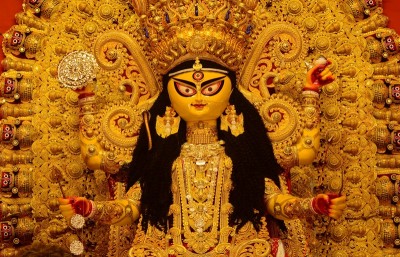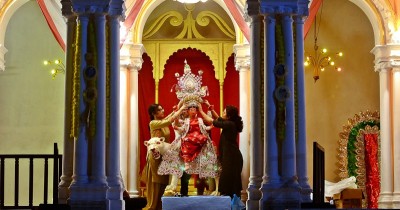
Museum sector in India needs to understand what the audience want: Vinod Daniel
Vinod Daniel, who spearheads the not-for-profit India Vision Institute (IVI), which promotes excellence in vision care delivery, is also a Member, International Council of Museums (ICOM), Paris. During his recent Kolkata visit IBNS-TWF correspondent Supriyo Hazra caught up with him to discuss his project and the challenges museums are facing amid the pandemic. Excerpts:
What made you come to Kolkata this time?
I have been to Kolkata about 25 times before. Prior to this visit, I have been here on numerous projects related to museums as well as vision. In this particular trip, I am concerned with both these aspects- museum and vision care. I was really delighted to give a lecture at Victoria Memorial this time. The setting of the grand location indeed made the entire event special. Meanwhile, my team is performing a vision screening project for underprivileged people in Bengal. In future, I will love to work in several such projects related to the concerned area.
How has the pandemic impacted museums across the world?
I feel that the biggest challenge which the museums face is in terms of the number of people who would visit the museums and experience everything which the institutions provide them. Typically, a museum which would attract a hundred people in a day might be able to accommodate less than half that number these days due to the pandemic. That shows the fear the public have with regard to public places, especially to close spaces. Until the world adjusts to the new normal, I feel the number of visitors will remain down by 40 to 50 percent.
Do you think that the governments across the world, including India, are promoting museums to students and other upcoming generations?
I would like to qualify your question. Overall, museums have a strong support of the government. In a place like India, most museums are either 100 percent undertaken or a substantial percent undertaken by the government. However, that is not the case in many other nations. During the pandemic, I am not sure whether museums in India had additional support. However the good part is that a substantial part of the support goes towards paying the staff salary. And I feel that part has been performed by the government in India as most of the employees are public servants. However, the museums really need government support in terms of their programming, exhibitions, outreach and education. I think only time will tell what will happen. I must add that it will be indeed a good step if the government provides some kind of assistance to non-governmental museums at this time of pandmeic.
Do you feel that students in this age of technology are missing the enthusiasm to visit museums?
Over the last period of nine to twelve months, most museums have remained shut. However, now they are opening up once more. Meanwhile, there has been a trend of engaging in developing online programmes and tools. I feel that it is good as it is one more way for museums to reach the public as physical visits have their own limits. I feel in the years to come, people will once again visit museums like they used to do in the normal period. The online tools will remain as an additional factor for museums. So, museums have this area of growth and capacity to expand its scope with these additional visitors. However, museums will now need to have enough resources to keep serving the online audience.

I don't think the current staff are well equipped to do it. New employees are needed to be employed and new initiatives are needed to be added to understand the audience better. Moreover, the authority will also need to learn the way of monetising the entire new aspect which is growing in recent times. My last point is that, one audience group which the museum misses out on are those aged between 15 to 35. So, the museum authority now has the opportunity to attract these people who are active online and on the social media platforms.
How can the conditions of Indian museums be improved in future?
The museum sector in India at this stage has a fantastic opportunity to grow. India can really rediscover itself in this arena. I think it is important that museums are given independence. I know there is a trust and there is a CEO and others who run it. It is important that this independence is respected. You can't really implement programmes and get the fund raising done without independence. The museums cannot be run as a public service arm by the government of the day. A good leader is needed who serves for at least 8 years. A good structure is also needed to move the sector forward. Apart from this issue, museums will also require skilled human resources. The pandemic has also changed the scenario a lot with this regard. Previously, you needed to hire a person and he needed to travel to a place to work there. However, with the availability of online technologies, experts, with proper needed skills, who are sitting far away can be hired on a part-time basis to help you. Now, that can be an answer until you develop your own skilled workers. So, there is a chance to capitalize the current situation with the help of technology.
What changes are required?
Museums in India also need to start changing their views. The museums need to understand how they can provide their content to the audience. They need to understand what the audience wants. All these are part of the process. Apart from them, keeping in mind the online aspect, one needs to understand that museums in India have good contents. India also has expertise and IT to translate the contents. Moreover, India has also got some of the best people in the movie sector. They can tell the story well. So, I believe it is time to put this combination in place to attract the audience. It will also make it easier to monetise as you cannot just do it by saying that I am putting all my collections online. The authority can also incorporate the Indian hetigate of dance and music to it and all these steps will really redefine the museology sector.
(Images by Avishek Mitra)
Support Our Journalism
We cannot do without you.. your contribution supports unbiased journalism
IBNS is not driven by any ism- not wokeism, not racism, not skewed secularism, not hyper right-wing or left liberal ideals, nor by any hardline religious beliefs or hyper nationalism. We want to serve you good old objective news, as they are. We do not judge or preach. We let people decide for themselves. We only try to present factual and well-sourced news.







